Beste Autofotografie Instellingen – Altijd de Perfect Foto
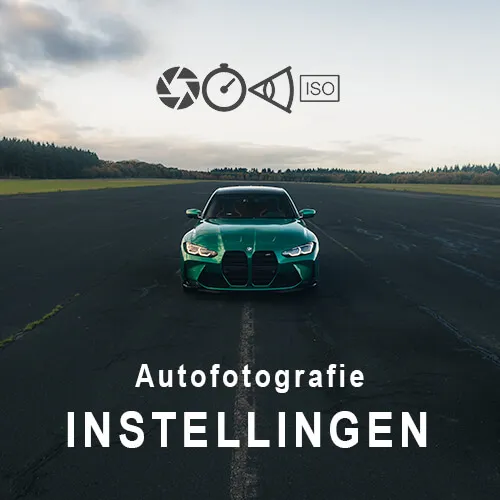
Autofotografie is erg leuk om te doen, waarbij je de snelste, mooiste en meest exclusieve auto’s vastlegt op een manier die de lijnen en emotie versterkt. Het vinden van de beste autofotografie instellingen is echter een ander verhaal, wat vaak lastig is.
Met jarenlange ervaring als autofotograaf moet ik zeggen dat ik dit onder de knie heb, het veranderen van instellingen om de perfecte foto te krijgen. Mijn doel is dat ook jij alle tips en tricks kunt toepassen.
In dit artikel vertel ik je precies welke trucjes ik gebruik om de beste instellingen te krijgen en zo de beste foto te maken. Deze tips heb ik uit persoonlijke ervaring verzameld, zodat jij ze direct kunt toepassen!
Wat zijn de beste instellingen voor autofotografie?
Autofotografie is een vak op zich en voor iedere situatie heb je verschillende camera instellingen. Welnu, de definitie van instellingen is vrij breed, laat me dat eerst verduidelijken. Camera instellingen verwijzen vaak naar ‘sluitertijd’, ‘ISO’ en ‘diafragma’, maar er zijn veel meer instellingen.
Laat ik eerst deze drie instellingen toelichten, die de basis vormen van autofotografie. Nadat je weet welke instellingen je moet gebruiken, kun je deze tips toepassen.
Sluitertijd, ISO & Diafragma
De sluitertijd van een camera is de periode waarin licht de sensor kan raken. Hoe langer de sluitertijd, hoe helderder de foto. Een sluitertijd van 1/50 seconde is bijvoorbeeld een stuk langer dan 1/1000 seconde. Dit betekent dat het licht de sensor 20 keer zo lang kan raken bij een sluitertijd van 1/50 seconde.
ISO heeft betrekking op de gevoeligheid van de sensor, dit getal wordt vaak uitgedrukt in 100, 200, 400 etc. Hoe hoger je de ISO instelt, hoe helderder (lichter) de foto wordt. Het voordeel is dat je met een hoge ISO de actie kunt bevriezen, maar het nadeel is dat je meer ruis in de foto krijgt.
Ten slotte hebben we het diafragma, dat is de hoeveelheid licht die door de lens kan gaan. Dit getal wordt uitgedrukt in F-stop. Een voorbeeld hiervan is F1.8, F3.5 en F8.0. Je kunt hier veel mee spelen omdat je dit op elke lens kunt aanpassen. De combinatie van deze drie instellingen bepaalt hoe licht/donker je foto is.
Scherpstel instellingen
Deze instelling wordt vaak vergeten onder autofotografen, maar kan echt het verschil maken tussen een scherpe en onscherpe foto. Veel nieuwe camera’s beschikken over uitgebreide autofocusmogelijkheden, zoals tracking met AI. Mijn camera (Canon EOS R6) heeft dat en ik gebruik dat de hele tijd.
Sinds ik deze functie heb, kan ik een stuk sneller foto’s maken, waardoor ik tijd bespaar en vaak in kortere tijd meerdere autolocaties kan bezoeken. Als je een camera zonder tracking hebt, raad ik aan om op enkelpunts AF te fotograferen en deze in het midden te plaatsen. Dit is vaak het meest nauwkeurige autofocuspunt.
Statische foto’s
Om met de eerste instellingen te beginnen, moet ik het simpel houden. Statische foto’s zijn technisch gezien de eenvoudigste foto’s om te maken. De auto staat stil en je hoeft in principe geen ingewikkelde combinaties van ISO, diafragma en sluitertijd te gebruiken.
Wanneer je statische foto’s maakt in fel zonlicht, moet je een kortere sluitertijd gebruiken. Voor statische autofoto’s gebruik ik vaak de volgende instellingen:
ISO: 100 – Sluitertijd: 1/250-1/500 – Diafragma: F1.4-F4.0
Ik zal even kort uitleggen waarom ik bovenstaande instellingen gebruik voor autofotografie. Voor statische foto’s staat de auto stil, waardoor ik geen hele snelle sluitertijd of hoge ISO hoef te gebruiken. De laagst mogelijke ISO heeft dan de voorkeur.
Vaak heb ik het diafragma op F4.0 staan, omdat de auto helemaal scherp is terwijl de achtergrond nog wat onscherp is. Ook heb ik gemerkt dat de lens rond dit diafragma vaak het scherpst is. Voor een nog onscherpere achtergrond kun je F1.4 gebruiken, maar je moet er wel rekening mee houden dat de auto niet helemaal scherp zal zijn.
Tenslotte pas ik de sluitertijd aan afhankelijk van de lichtomstandigheden. Bij fel zonlicht gebruik ik 1/500-1/1000 seconde, maar als het bewolkt is kan de sluitertijd snel oplopen naar 1/160-1/250 seconde.
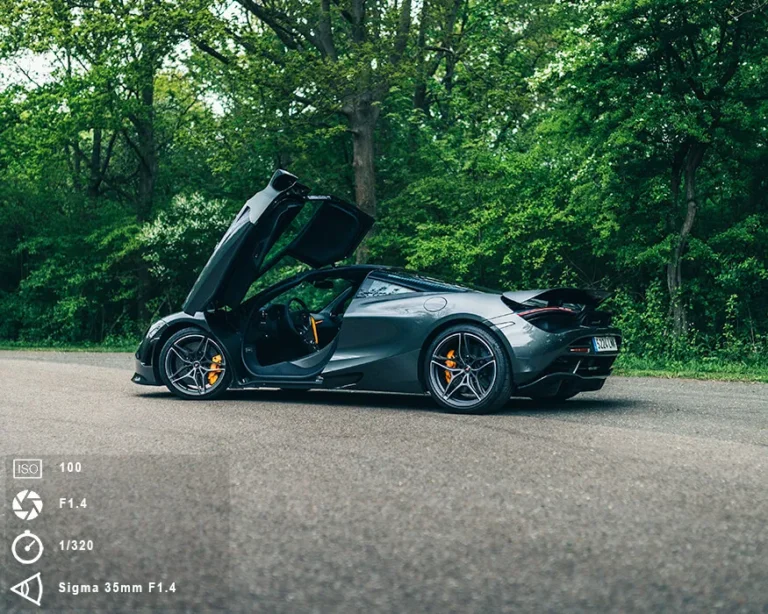
Rolling shots (Rijdende foto’s)
Het tweede type foto is de rolling shot, ook wel rijdende foto’s genoemd. Met deze techniek kun je veel beweging visualiseren, waardoor mensen een gevoel van snelheid kunnen krijgen. Ik denk dat dit een van de leukste soorten foto’s is om te maken tijdens een fotoshoot.
De techniek hierachter is echter ook een van de moeilijkste om onder de knie te krijgen; de instellingen voor rolling shots kunnen ingewikkeld zijn. Ook hier zijn de instellingen nooit hetzelfde, maar tijdens bewegende opnames gebruik ik vaak onderstaande instellingen.
ISO: 100 – Sluitertijd: 1/20-1/50 – Diafragma: F5.6-F11
Ook dit keer zal ik de instellingen uitleggen, zodat je ze kunt begrijpen en zelf kunt toepassen. Net als bij de vorige opname stel ik de ISO zo laag mogelijk in, omdat het licht de sensor heel lang kan verlichten. Een ISO van 100-200 is laag genoeg voor rolling shots.
Het valt meteen op dat de sluitertijd een stuk langer is dan bij de statische opname omdat dit de instelling is die voor een bewegend effect zorgt. Hoe langer de sluiter, hoe meer beweging. Voor bewegende autofoto’s vind ik een sluitertijd van 1/20-1/50 perfect, waardoor ik veel beweging en ook veel scherpe foto’s heb.
Op het kleine schermpje van de camera kun je vaak niet zien of een foto helemaal scherp is, daarom raad ik een langere sluitertijd niet aan. Om deze sluitertijd te compenseren gebruik ik een klein diafragma, rond F5.6-F11 zou voldoende moeten zijn. Als het beeld toch te helder is, raad ik een ND-filter aan.
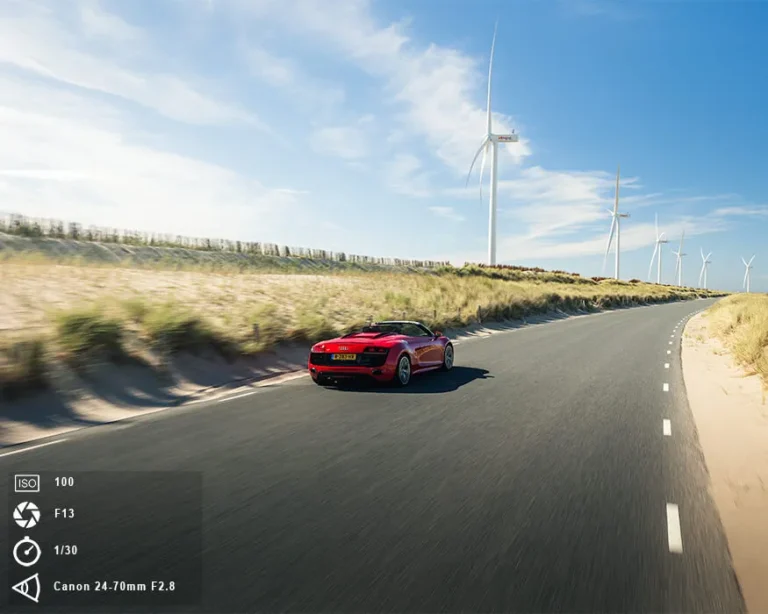
Op de foto hierboven kun je zien dat ik een Audi R8 heb gefotografeerd, de instellingen die ik heb gebruikt heb ik erbij gezet. Bij elk van de volgende foto’s zal ik uitleggen wat mijn manier van denken was om tot het resultaat te komen.
Om hiermee te beginnen reden we met een auto van ongeveer 30 km/u achter het hoofdonderwerp aan. Ik ging op de deur zitten met het raam open, zodat ik mezelf kon vasthouden. Met een sluitertijd van 1/30 kon ik voldoende beweging vastleggen.
Ik heb de ISO uiteraard zo laag mogelijk ingesteld en het diafragma op deze foto was F13, wat vrij klein is. Om dit te voorkomen raad ik je aan een ND-filter te bestellen, de meeste lenzen worden na F11 minder scherp door diffractie.
Instellingen voor in de nacht
Autofotografie in de nacht is een heel ander soort sport, omdat je hier goed op de instellingen moet letten. Als de omgeving donker is, kun je twee dingen doen: de camera zo instellen dat het licht heel lang op de sensor kan vallen, of een externe lichtbron gebruiken om de auto te verlichten.
Als je geen lichtbron gebruikt, heb je een statief nodig om bewegingen te voorkomen die het beeld onscherp maken. Voor autofotografie ‘s nachts gebruik ik vaak de volgende instellingen:
ISO: 800-1600 – Sluitertijd: 5s-10s – Diafragma: F1.4-F2.8
Omdat het zo donker is, moet je een lange sluitertijd gebruiken, zodat de camera toch voldoende licht kan krijgen om een evenwichtig beeld te maken. Je moet het diafragma zo ver mogelijk openen, zodat de lens veel licht kan binnenlaten.
De ISO is afhankelijk van de situatie, gebruik indien nodig een hogere ISO. Vaak is een ISO van 800-1600 goed genoeg, maar soms moet je een nog hogere ISO gebruiken. Het is van cruciaal belang dat de belichting in de camera correct is; het is moeilijk om een onderbelichte opnames te corrigeren.
Wanneer je een lichtbron, zoals een lichtbalk, gebruikt moet je dezelfde instellingen gebruiken als hierboven, maar een iets lagere ISO. Hierdoor wordt de foto een stuk ‘schoner’ en wordt de auto goed belicht door middel van lichte strepen.
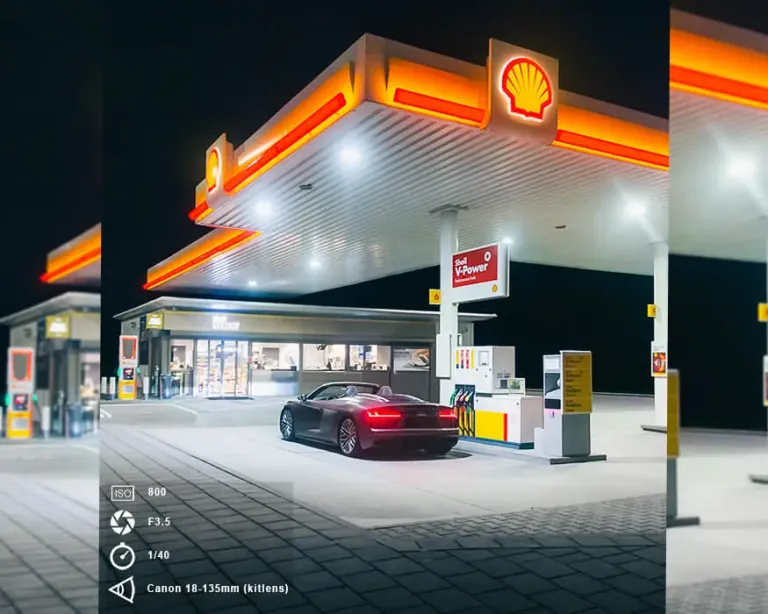
Ik ga ‘s nachts niet vaak met de auto op pad, deze foto heb ik in 2020 gemaakt, dus het is alweer een tijdje geleden. Ik heb hiervoor een Canon 70D gebruikt, wat niet de nieuwste of duurste camera is. Dat bewijst maar weer dat een dure autofotografie camera niet nodig is.
De lens was een 18-135mm lens, die ik voor deze foto op 18mm heb ingesteld. Het grootste diafragma is F3.5, dus stel dat in. De lens beschikt over stabilisatie, dus ik had de sluitertijd nog langer kunnen instellen, maar dat heb ik in dit geval niet gedaan.
Met een sluitertijd van 1/40 weet ik zeker dat de foto scherp wordt, maar omdat ik een statief ben vergeten kan ik de ISO niet op 100 zetten, anders wordt de foto te donker. Met ISO van 800 kom je behoorlijk ver, zo kwam ik bij de instellingen voor autofotografie ‘s nachts uit.
Tips voor zonsondergang
Tijdens een zonsondergang maak ik vaak de mooiste foto’s, met de gouden gloed op de achtergrond kun je werkelijk unieke foto’s maken die iedereen mooi zullen vinden. Wel merk ik één probleem dat ik vaak heb tijdens zonsondergangen: de auto is vaak te donker of de lucht is vaak te licht.
Gelukkig heb ik een oplossing gevonden om dit probleem op te lossen. De instellingen die je moet gebruiken tijdens een zonsondergang variëren sterk per situatie. Om te voorkomen dat de auto te donker is of de lucht te helder, kun je een HDR maken. Dit doe je door drie foto’s te maken met verschillende instellingen.
Ik gebruik hiervoor vaak de volgende instellingen:
ISO: 100 – Sluitertijd: 1/80-1/160-1/320 – Diafragma: F1.4-F4.0
De instellingen voor autofotografie bij zonsondergang zijn vrij eenvoudig, je hebt een standaard ISO en diafragma. Ik gebruik vaak ISO 100 en een diafragma van F1.4-F4.0. Dan kun je drie foto’s maken met de volgende sluitertijden: 1/80-1/160-1/320. Ten slotte kun je deze drie foto’s samenvoegen om één foto te krijgen waarop de auto niet onderbelicht is en de lucht niet overbelicht is.
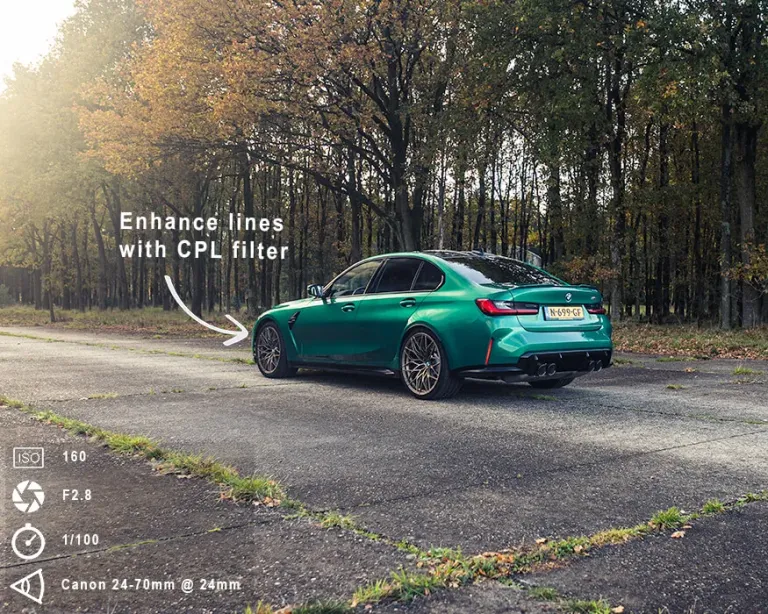
Op deze foto zie je de gouden gloed waar ik het net over had, linksboven geeft dat een mooi effect. Ik heb ervoor gezorgd dat de zon niet direct zichtbaar is, zo vermijd je dat de zon direct in de lens schijnt wat het contrast vermindert.
De instellingen zijn redelijk eenvoudig, met de ISO relatief laag en het diafragma wijd open. Wat de sluitertijd betreft, heb ik deze aangepast aan de situatie, in dit geval was deze 1/100.
Hier kun je het gebruik van het CPL-filter zien, het volgende onderwerp waar ik het over zal hebben. Door het filter naar de zijkant van de auto te draaien komen de lijnen mooi naar voren.
Reflecties (CPL filter)
Tijdens iedere situatie die ik hierboven noemde heb je last van reflecties, en om dit te voorkomen kun je gebruik maken van een Circulair Polarisatie Filter (CPL). Door eraan te draaien kun je een deel van de reflecties op de auto verwijderen.
Ik raad je zeker niet aan om altijd een CPL-filter te gebruiken, want autofotografie gaat naar mijn mening ook over de omgeving en hoe de lijnen reageren op de omgeving. Vaak kun je de omgeving gebruiken om de lijnen van een auto meer te laten opvallen. Als je dit onder de knie hebt, kan dit een krachtig hulpmiddel zijn.
Je moet de locatie van een autofotoshoot als hoge prioriteit beschouwen, deze kan de foto’s maken of breken.
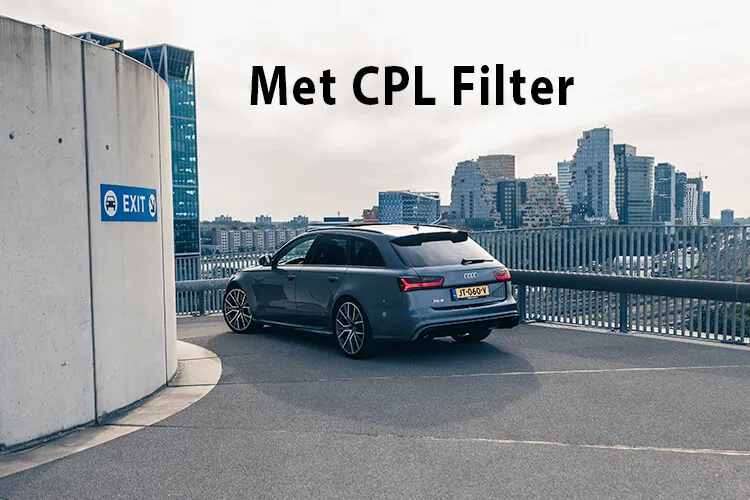
Op de bovenste foto heb ik het CPL-filter naar de zijkant van de auto gedraaid. Ik raad aan om het filter zo te draaien dat het grootste oppervlak van de auto reflectievrij is. In dit geval is het de zijkant, maar soms is het ook de achterkant of voorkant.
Op onderstaande foto zie je dat het filter is weggedraaid, waardoor de reflectie weer zichtbaar is. Ik vind de onderste hier mooier omdat ik de reflectie bijdraagt aan de foto en sfeer. De lijnen van de auto komen veel beter naar voren en dit is de betere optie.
Speel eens met een CPL-filter en probeer verschillende technieken. Ik maak vaak meerdere foto’s waarbij ik het filter tussen de foto’s draai, zodat ik later kan kiezen welke ik mooier vind.
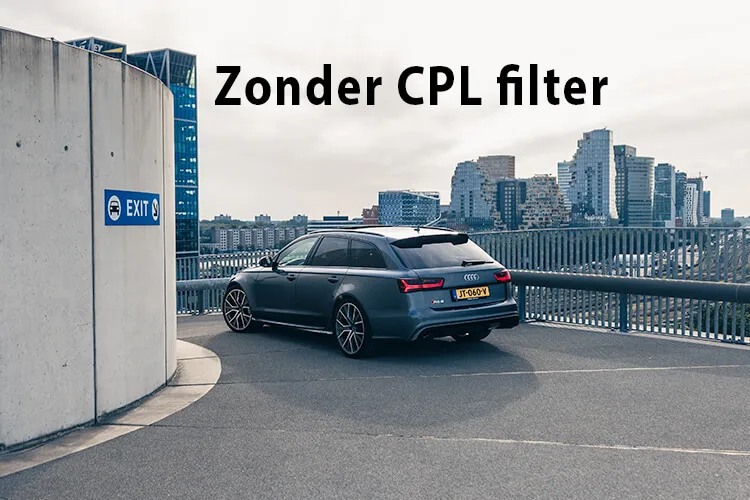
Kies de juiste lens
Ik zeg het keer op keer: lenskeuze is een van de belangrijkste aspecten van autofotografie. Het gaat er niet om of een lens duur of goedkoop is, hoe goed de kwaliteit is of niet. Het gaat over het effect dat elke lens kan hebben op een auto en zijn omgeving.
Wanneer je geld wilt verdienen is het al helemaal belangrijk om in een goede lens te investeren!
Een groothoeklens kan de auto vervormen en veel van de achtergrond opnemen, terwijl een telelens de achtergrond erg comprimeert en de focus op de auto legt. Beide typen lenzen hebben hun voor- en nadelen, mijn voorkeur gaat uit naar een 24-70mm lens.
Je kunt niet elke willekeurige lens gebruiken voor alle hoeken, daarom is de 24-70mm mijn favoriet!
Tips voor bewerkingen
Tenslotte kan ik dit niet achterwege laten, want het maken van de foto’s is maar het halve werk. In de andere helft gebeurt de magie: als je het bewerken goed onder de knie hebt, kun je prachtige effecten aan een foto geven.
Ik zeg niet dat je alles moet photoshoppen, ik geef de voorkeur aan een natuurlijke uitstraling omdat het tijdloos is en over 10 jaar nog steeds mooi zal zijn. Ik heb in het verleden veel geprobeerd en dat is de enige manier waarop je kunt leren.
Ik kan je wel een paar tips geven, door bijvoorbeeld een masker op de auto te plaatsen en de helderheid te vergroten kun je de lijnen van een auto verduidelijken. Voor de achtergrond kun je het tegenovergestelde doen; door de helderheid van de achtergrond te verlagen kun je de focus ervan wegnemen.
Probeer met verschillende maskers te werken en kleurverlopen toe te voegen, zodat je meer aandacht op de auto kunt vestigen en de finishing touch kunt aanbrengen. Vaak heb je geen controle over situaties, bijvoorbeeld een vies wegdek. Je kunt dit ook in Photoshop oplossen, zoek gewoon een paar tutorials online.
Hoe je maskers toevoegt, leg ik hieronder in detail uit!
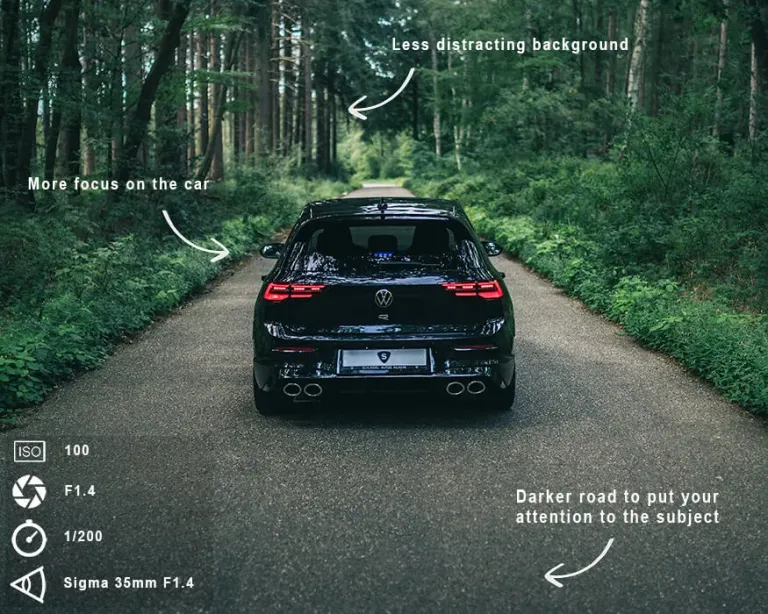
Hoe kan je een masker toevoegen in Lightroom?
In de volgende serie foto’s leg ik je uit welke maskers ik heb toegevoegd om het bovenste resultaat te krijgen met uitleg in Lightroom. Je kunt het dus kopiëren om jouw resultaten te verbeteren.
Op de foto hierboven kun je zien welke aanpassingen ik ga doen om de aandacht op de auto te vestigen, het zijn handige trucjes die je kunt gebruiken.
Zorg ervoor dat je ‘Kleuroverlay’ linksonder in ‘Overlaymodus’ hebt ingeschakeld, zodat je dezelfde instellingen hebt als ik.
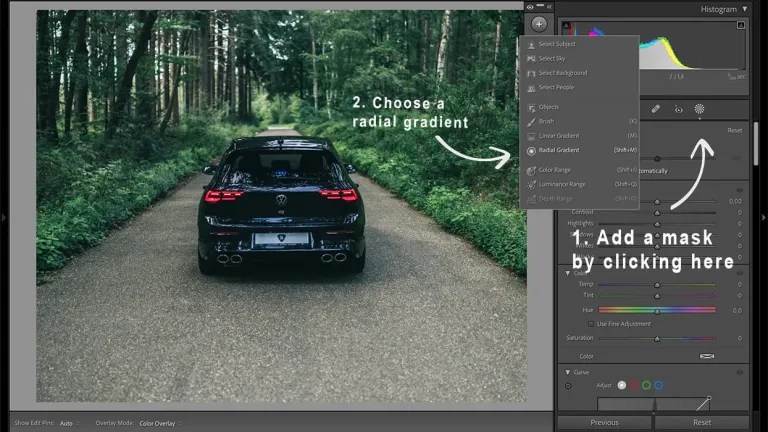
1. In Lightroom kun je veel bewerkingsinstellingen aanpassen, waaronder het toevoegen van maskers. Zo kun je één deel van de foto aanpassen terwijl de overige delen onbewerkt blijven. Klik op het logo dat je bij de pijl ziet.
2. Door op de ‘+’ (bovenaan het scherm) te klikken krijg je een heel menu met maskeropties. Kies eerst voor de ‘radiaal verloop’, dit is een cirkel die je zelf kunt aanpassen.
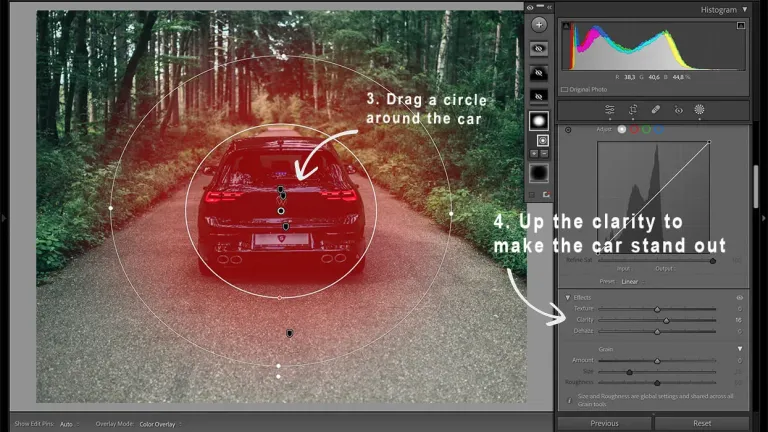
3. De volgende stap is om een cirkel over de auto te tekenen, zodat de auto helemaal rood is. Het maakt niet uit of je wat meer van de omgeving meeneemt in je selectie, het maakt het geheel naar mijn mening mooier.
Zorg ervoor dat de veer niet te klein is, zoals ik hierboven liet zien is dit ongeveer wat ik altijd gebruik.
4. Zorg ervoor dat je de helderheid verhoogt, helderheid zorgt ervoor dat er meer contrast, scherpte en detail worden toegevoegd. Dit doe ik om de auto er beter uit te laten zien.
Pas op dat je dit niet te veel doet, het kan ook erg afleidend zijn als het overdreven is.
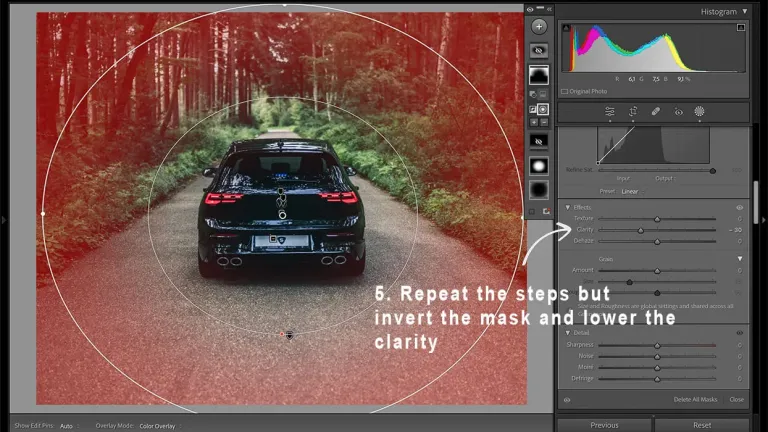
5. Herhaal vervolgens stap 1 t/m 3, maar klik nu op ‘masker omkeren’. Die knop zie je bovenaan boven ‘Doezelaar’. Als je dit aanvinkt zie je alles rondom de cirkel rood.
Zorg er in dit geval voor dat je de helderheid lager zet, zodat er minder scherpte en detail zichtbaar zijn en de achtergrond minder afleidt. Vooral in bosrijke gebieden is deze instelling een must.
Wat je kunt doen is de belichting met -0,10/-0,50 verminderen. Zo is de omgeving iets donkerder dan de auto en dat zorgt er ook voor dat de aandacht naar de auto wordt getrokken.
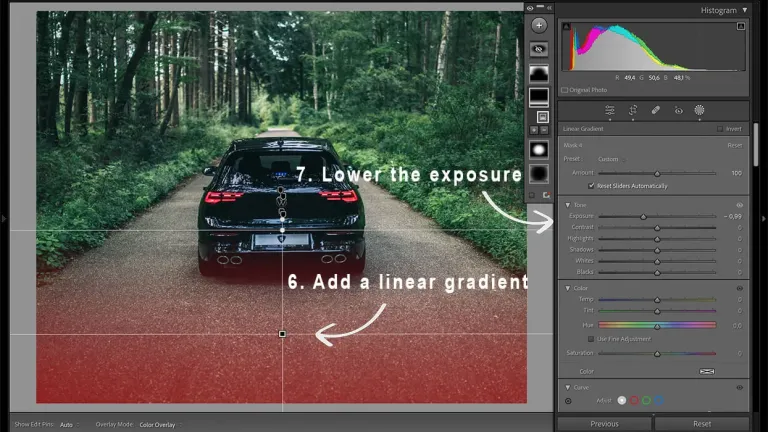
6. Tenslotte kun je de onderkant van de foto donkerder maken, zodat deze minder afleidt. Al met al zorg je ervoor dat de aandacht automatisch naar de auto gaat en niet naar de weg.
Zorg er eerst voor dat je een lineair verloop op de bodem toepast. Het rode gedeelte is wat je gaat aanpassen, dus dat moet onderaan de lijn staan.
7. Stel als laatste stap een donkerdere belichting in, waardoor de weg (onderkant) donkerder wordt dan de rest. Dit doe ik nooit te donker, door alles subtiel te doen blijft de foto een mooi geheel.
Dit waren alle stappen die je moet nemen om de maskers toe te voegen. Het is een vrij eenvoudig proces en je hoeft alleen maar te weten hoe je het moet doen. Doe alle instellingen subtiel en zet geen +100 of -100 helderheid, dan lijkt het meer op een tekening dan op een mooie foto.
Conclusie
Nu ik je een paar tips heb gegeven voor autofotografie instellingen, kun je ze in het echt gaan toepassen. Je kunt talloze handleidingen lezen, video’s bekijken of cursussen kopen, maar je leert niets als je het niet toepast.
Dus ik geef je de opdracht: ga op pad met je camera en auto, het maakt niet uit welke. Probeer een nieuwe techniek uit, of het nu gaat om rolling shots, nachtfotografie of zonsondergangfoto’s. Als je de instellingen hebt geprobeerd en resultaat hebt, kun je het naar mij sturen. Wellicht kan ik je nog wat aanvullende tips geven.
Vergeet deze tips niet te delen met onze collega-fotografen via onderstaande buttons, ik vind dat we er voor elkaar moeten zijn en we hebben er allemaal baat bij als ook jij mooie foto’s kunt maken met de juiste instellingen.
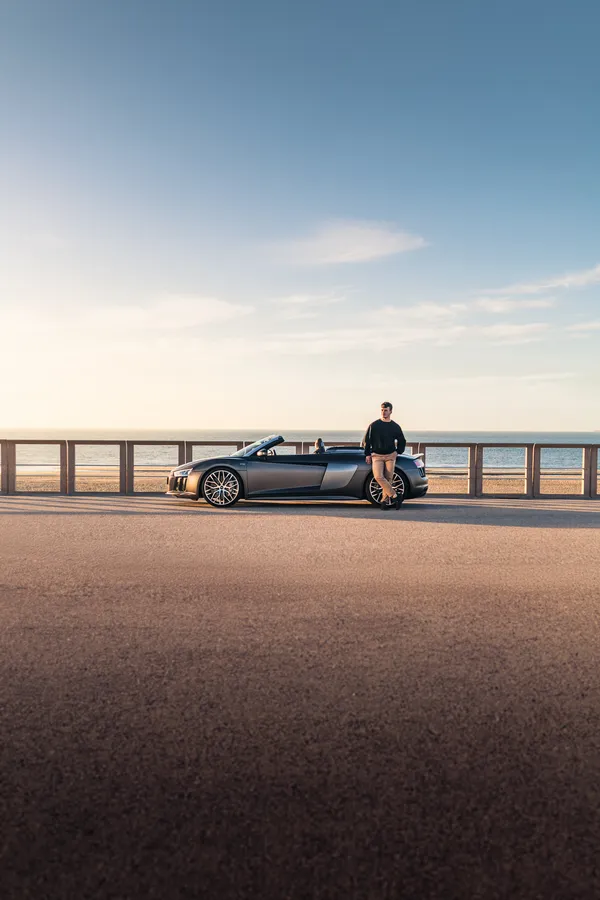
Wie is Sebastiaan?
Hoi! Ik ben Sebastiaan, de schrijver van dit blog. Met jarenlange ervaring als professioneel fotograaf wil ik mijn expertise met jou delen. Van het aanbevelen van camera’s en lenzen tot het geven van tips die een wereld van verschil maken, dat is wat ik het liefste doe.